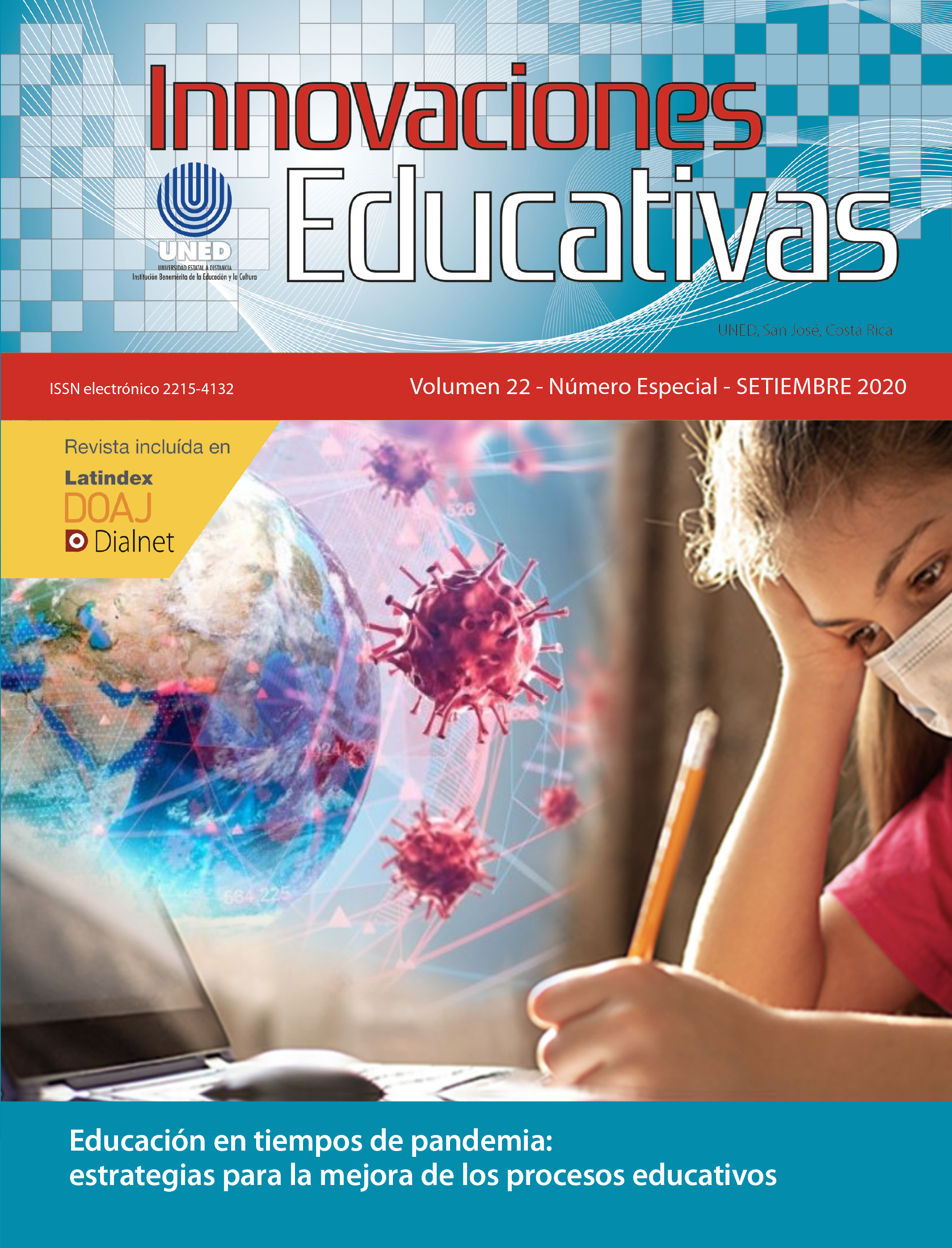Didactic strategies used in remote presence at Universidad Nacional’s Education for Work Division during pandemic times
DOI:
https://doi.org/10.22458/ie.v22iEspecial.3251Keywords:
Educational strategies, learning, teaching, higher education, didactic strategies, remote presence, COVID-19Abstract
The article presents the didactic strategies used in the Division of Education for Work (DET) of Universidad Nacional (UNA) in Costa Rica to implement remote presence as a response to the changes in the educational processes produced by the virus responsible for COVID-19. To specify the above, the teaching staff and students of the aforementioned Academic Unit participated during the first cycle and the first part of the second cycle of 2020, through a quantitative study with a non-probabilistic sample of voluntary participants through the survey technique. It was determined that the strategies put into practice by the teachers were opportune to produce the desired effect (learning from remote presence) in the lived context, given that the didactic proposals were diversified towards the student body and the perception of this was that. The learning objectives of the different subjects of the Baccalaureate and Bachelor's Degree in Guidance were achieved, and it also allowed an intensive use of technological resources to mediate learning. Finally, the study demonstrated the need to clarify the conceptualization of remote learning in academic staff, in addition to delving into future research processes that allow reflection on other elements of this modality, such as its curricular relevance, technological and pedagogical access.
References
Bertogna, L., Del Castillo, R., Soto, H. y Cecchi, L. (s.f.). Clases Sincrónicas Virtuales en la Enseñanza a Distancia: una implementación a bajo costo. Recuperado de http://sedici.unlp.edu.ar/bitstream/handle/10915/19102/Documento_completo.pdf?sequence=1
Calderón, K. (2015). La didáctica: concepciones y aplicaciones. San José, C.R: EUNED.
Colom, A., Sureda, J., Salinas, J. (1988). Tecnología y medios educativos. Barcelona: Cincel-Kapelusz.
Creswell, J. (2009). Research Design. Qualitative, Quantitative and Mixed Methods Approaches. United States: Sage.
Díaz-Barriga, F. y Hernández, G. (2005). Estrategias docentes para un aprendizaje significativo. Una interpretación constructivista. México: Mc Graw Hill Interamericana.
División de Educación para el Trabajo [DET] (2020). ¿Quiénes somos?. Recuperado de https://www.cide-trabajo.una.ac.cr/index.php/quienes-somos
Elacqua, G. y Schady, N. (2020). La educación ante el Covid-19 en América Latina: Retos y alternativas de política. Banco Interamericano de Desarrollo. Recuperado de https://blogs.iadb.org/educacion/es/retosyalternativasdepoliticaeducativa/
Espinoza, E. (2017). El aprendizaje en estudiantes universitarios. Cienfuegos, Cuba: Editorial Universo Sur. Recuperado de https://elibro.net.una.remotexs.co/es/ereader/unacr/71777?page=24.
Good, T. y Brophy, J. (1986). School effects. En: Wittrock, M. (Ed.). Handbook of research on teaching. New York: MacMillan.
Guevara, C. (2017). La estrategia didáctica y su uso dentro del proceso de enseñanza y aprendizaje en el contexto de las bibliotecas escolares. E-Ciencias de la Información. 7 (1). 1 – 22. http://dx.doi.org/10.15517/eci.v7i1.27241
Hernández, R., Fernández, C., Baptista, P. (2014). Metodología de la Investigación. Sexta Edición. México: Mc Graw Hill.
Hodges, C.; Moore, S.; Lockee, B.; Trust, T. y Bond, A. (2020). The Difference Between Emergency Remote Teaching and Online Learning. En Educause Review. Recuperado de https://er.educause.edu/articles/2020/3/the-difference-between-emergency-remote-teaching-and-online-learning
Ilinois State Board of Education (2020). Recomendaciones de aprendizaje remote. Recuperado de https://www.isbe.net/Documents/RL-Recommendations-Spanish.pdf
Jiménez, A. y Robles, F. (2016). Las estrategias didácticas y su papel en el desarrollo del proceso de enseñanza aprendizaje. Revista EDUCATICONCIENCIA. 9 (10). 106 – 113. Recuperado de http://192.100.162.123:8080/bitstream/123456789/1439/1/Las%20estrategias%20didacticas%20y%20su%20papel%20en%20el%20desarrollo%20del%20proceso%20de%20ense%C3%B1anza%20aprendizaje.pdf
Picado, F. (2014). Didáctica general. Una perspectiva integradora. San José, Costa Rica: EUNED.
Rivera, E. (2020). La tecnología como herramienta de aprendizaje. Recuperado de https://www.cuc.ac.cr/userfiles/files/BLOG/Blog%2027%20de%20marzo%252c%20La%20tecnolog%C3%ADa%20como%20herramienta%20de%20aprendizaje.pdf
Tijo, S. (2020). Enseñanza remota de emergencia en ingeniería civil: lecciones aprendidas. Encuentro Internacional de Educación en Ingeniería. Recuperado de https://acofipapers.org/index.php/eiei/article/view/781
UNESCO (2020). Sistematización de respuesta de los sistemas educativos de América Latina a la crisis de la COVID-19. Recuperado de https://www.siteal.iiep.unesco.org/respuestas_educativas_covid_19
Universidad Nacional. (2007). Modelo Pedagógico. Heredia: Universidad Nacional. Recuperado de http://www.documentos.una.ac.cr/bitstream/handle/unadocs/3084/Modelo%20Pedagogico.pdf?sequence=1&isAllowed=y
Universidad Nacional. (2015). Estatuto orgánico. Heredia: Universidad Nacional.
Vicerrectoría de Docencia (2020a). Orientaciones metodológicas y evaluativas para apoyar la adaptación de los cursos presenciales a sesiones con apoyo tecnológico. Heredia: Universidad Nacional. Recuperado de http://www.documentos.una.ac.cr/bitstream/handle/unadocs/11533/De-la-presencialidad-al-trabajo-academico-remoto-2020.pdf?sequence=1&isAllowed=y
Vicerrectoría de Docencia (2020b). Encuesta posibilidades de uso de tecnologías del estudiantado. Heredia: Universidad Nacional. Recuperado de http://www.docencia.una.ac.cr/resultado-de-la-escuesta-por-estudiante/caracteristica-tecnologicas/resultado-utilizado-herramientas-tecnologicas

